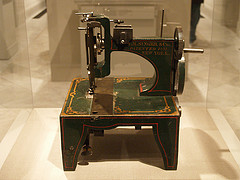Practical Ways to Green Your Home Sewing Hobby
 Sewing is a fun and practical hobby that helps aficionados save money while getting exactly the fashion look that they want. If you are a "sewist," as they say, you can bring together both your love of sewing and your concern for the state of the planet when you try out these tips and tricks for greening your favorite hobby.
Sewing is a fun and practical hobby that helps aficionados save money while getting exactly the fashion look that they want. If you are a "sewist," as they say, you can bring together both your love of sewing and your concern for the state of the planet when you try out these tips and tricks for greening your favorite hobby.
3 Rs of Sewing
When you know how to sew, you can take the basic 3 Rs of green living -- Reduce, Reuse, Recycle -- into a whole new dimension as you Repair, Refit and Revitalize. The first green principle of sewing, repairing (aka mending), is a time-honored skill that keeps your beloved, still-wearable clothes in active use via patching, strategic placement of embroidery, or simply re-sewing a torn seam. Refitting means adjusting your outfits to changes in body size and shape. Here, creativity can be a plus. For example, taking in a skirt is easy enough, but what if you need it to be made larger? For an A-line or other loose-fitting style, cut a few inches off the top until it fits you at the waist. Finish the new waistline and lengthen the bottom of the skirt with an added ruffle, if desired. Revitalizing is also an artistic challenge. Update tired shirts or pants with appliqués, topstitching, braid … you're limited only by your imagination.
Eco-Friendly All the Way
When the time comes that you really must add a new garment or two to your wardrobe, make sure to buy cruelty-free eco-friendly fabrics. Synthetic materials and some fabric finishes tend to offgas dangerous VOCs. Try to stick with sustainable, organic cotton, wool, hemp, and the like. Fabric should be locally produced if at all possible, and either undyed or printed with low-impact pigments. Don't forget to look for green notions to complete your sewing project. Thread, zippers, bindings, and even quilt batting come in environmentally safe versions, as well.
Reuse, Reuse, Reuse
Home sewing is full of opportunities to reuse. If you find a dress or pair of curtains made out of gorgeous vintage material at your local thrift shop but they don't quite work for you as is, why not give the cloth a new lease on life? You may want to color it a different shade with botanicals, following the eco-dyeing process developed by textile artist India Flint. These do not give the bright, artificial hues you'll get from regular dyes but, rather, earthier effects that echo the terracotta of an Atlanta tile roof or the misty green of a Pacific Northwest spring morning. When you get good results from a certain sewing pattern, run it up again in a completely different fabric type. For additional interest, change the sleeve style or garnish with patch pockets. Even small items like a great set of buttons or some unique trim can be carefully removed from an old outfit to add interest to a new one.
Waste Not, Want Not
As with home pastry baking, one of the most enjoyable parts of sewing is using up the scraps. Odds and ends of fabric can be repurposed for so many things. Here are just a few suggestions to get you started -- replacement collars, décor on homemade costumes, patchwork quilts, cushion cases, baby bibs, stuffed animals, book covers, and wine bottle gift bags. If you look around for more interesting ideas for sewing with fabric scraps, you can find inspiration enough for holiday and birthday gifts to suit just about everyone you know.
Laura Firszt writes for networx.com.
Looking for a Pro? Call us (866) 441-6648

Average Costs
Related Experiences

Oak Tree Planting Looks Great In Our New Home’s Spacious Yard

Friendly And Professional Lawn Service Earns My Loyalty



